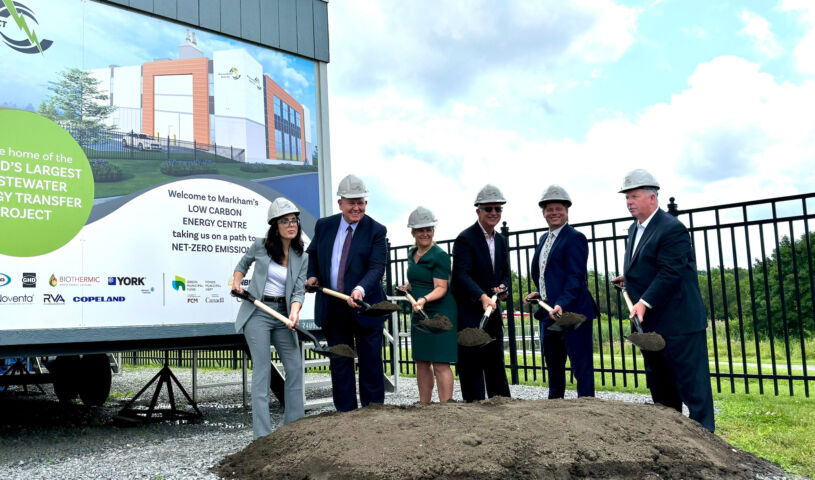FCM’s Green Municipal Fund celebrates its most impactful year
 Dignitaries, including Deputy Prime Minister and Minister of Finance Chrystia Freeland, visited Markham District Energy – the city’s public energy utility and Canada’s fastest growing energy utility – on July 16 to highlight how federal investments, including from the Federation of Canadian Municipalities’ Green Municipal Fund, are expanding Markham’s affordable, low-carbon energy network to more residents and businesses. Photo: FCM Media Relations
Dignitaries, including Deputy Prime Minister and Minister of Finance Chrystia Freeland, visited Markham District Energy – the city’s public energy utility and Canada’s fastest growing energy utility – on July 16 to highlight how federal investments, including from the Federation of Canadian Municipalities’ Green Municipal Fund, are expanding Markham’s affordable, low-carbon energy network to more residents and businesses. Photo: FCM Media Relations
Impact can be difficult to measure. But by about any metric he can think of, Chris Boivin is quick to celebrate the Green Municipal Fund (GMF)’s 2023-24 fiscal year as an unqualified success.
The GMF was created in 2000 and is managed by the Federation of Canadian Municipalities (FCM). The GMF provides funding and support to help towns and cities become more sustainable and resilient.
Boivin, FCM’s chief development officer and the GMF’s managing director, said it is difficult to narrow down a list of the program’s successes. This, he said, is especially true given the many initiatives the GMF approved and the large amount of money committed to projects with enormous potential to impact the sector.
“Climate change mitigation was a significant challenge and objective for municipalities,” Boivin said. “When we look at the balance of the quality of the projects, the number of them, and the potential for even more, that’s how we arrive on the most impactful yet.”
Growth in 2023-24
In early September, the GMF released its 24th annual report for the fiscal year of 2023-24. The success of the fund is reflected in the nearly $200 million invested in projects and the launch of over $820 million in new funding through the Local Leadership for Climate Adaptation and Growing Canada’s Community Canopies initiatives. Both these initiatives launched this past spring through funding agreements with the federal government.
Boivin has been with the GMF for some seven years. And each year, he said, the GMF sees “a raising of the bar.”
Boivin said the fund’s impact is clear, with investments nearing $200 million this year and even higher expectations for next year. By comparison, just five years ago GMF commitments were around $50 million per year.
“Even when I joined seven years ago, there was a fairly strong sense of the importance of sustainability in communities,” Boivin said. “In the past four or five years in particular, we’ve seen a very significant increase in the number of commitments that municipalities have made to very ambitious climate plans.”
Key Fund Highlights
Boivin said he sees the increasing impact of the GMF as having “a healthy amount of performance pressure.” He is quick to laud the efforts of the team at the GMF, and at the FCM more broadly, in working on these critical societal challenges every day.
“I would say where we feel it (the GMF) is, you need to deliver on expectations,” Boivin said. “It’s not a small amount that has been entrusted to us, and it’s certainly not a small mandate.”
Some key highlights of the 2023-24 report include:
- developing a wide range of partnerships, including with governments, businesses, and community organizations, to leverage resources, and expertise to amplify municipalities’ ability to fight against climate change
- introducing a new measurement framework for Reconciliation and anti-racism, equity, and inclusion along with setting annual targets for staff, governance, and programming to ensure equitable outcomes
- allocating over $35 million in GMF’s Sustainable Affordable Housing initiative to support the planning and development of more affordable, and energy-efficient housing units across Canada
- expanding GMF’s Community Efficiency Financing initiative to allow energy-efficient retrofits across Canada, including in Newfoundland and Labrador, a province with the highest rate of energy poverty (approved $38 million in funding for 19 projects)
Success Stories Large and Small
Boivin acknowledged how difficult it is to pick out even a few of the fund’s recent success stories. After all, there are “quite a range” of projects that he said it is easy to get excited about.
One example he highlights is an $8.77-million investment from GMF in Markham, Ont. This project involves the City of Markham researching, designing, and constructing a pilot neighbourhood of 311 homes. These homes will connect to a geo exchange-based community energy system. The two partners in this groundbreaking project, Enwave Energy Corporation and Mattamy Homes, worked pro-actively to convene the public and private sectors to help bring the residential housing sector closer to net-zero emissions.
“It’s exciting because there’s a tremendous opportunity to replicate this in many jurisdictions for development,” Boivin said. “It’s just very prescient to not just look at the roads and the aboveground wires and water lines, but actually to think through how you create a net-zero energy provision for brand new development today.”
Another project Boivin is quick to celebrate is an arena retrofit project in Ituna, Sask. The Ituna community arena was built in 1961 and was at risk of being declared unsafe to use without a much-needed retrofit.
The updated building will be a modern, functional, and energy-efficient recreational space that everyone in and around the community can enjoy. Ituna has a population of 700, but the upgraded facility will also benefit residents of many neighbouring communities that capture a total area population of some 8,200.
“You can imagine what kind of value that brings, not just to Ituna, but to the neighbouring communities as well. To have a brand-new critical community asset that’s going to be able to serve them for the next 30, 40, 50 years, but at a very high energy standard. It’s an example of probably hundreds of facilities like this across Canada’s small towns. So again, lots of replication potential for that.”
Support for All Communities
Building resilient infrastructure and adapting systems to withstand climate change impacts is crucial. But this points to the need to foster impact in smaller communities, such as Boivin alluded to in Ituna.
Boivin said getting buy-in from communities outside of Canada’s large cities is essential in achieving the nation’s net-zero goals.
There is a perception that change is only driven by big projects in large cities. This, Boivin said, isn’t true, and is the opposite of the GMF’s mandate. He said the fund is essential because it helps towns and cities that don’t have enough staff or money to complete important projects by themselves.
Obviously, the staffing available in a town of 700 people, for example, compared to a city of 100,000 is quite different, Boivin said. As such, the goal is often addressing the question of how the GMF can help get enough bandwidth or attention from the staff that are in those smaller communities so they can be armed with everything they need to take on these kinds of transformational projects.
“It’s not just funding. It’s here’s your guide on how to do it right. Here’s how to make sure you’re making the best decision, identifying the best vendor, best planning approach, and so on,” Boivin said. “And that was done primarily for the smaller municipalities, recognizing that gap, and the need for them to engage equally on this path toward transforming their communities.”
GMF Nationwide Impact
GMF provides funding and education to municipalities to help them both reach net zero and build resilient communities.
Since its launch in 2000, the fund has supported the reduction of greenhouse gas emissions by 2.9 million tonnes while funding more than 13,000 person-years of employment. Additionally, it has supported more than 30,000 sustainable affordable housing units and contributed $1.24 billion to the national GDP through over 2,300 approved projects. GMF manages approximately $2.4 billion in programs funded by the federal government.
As impressive as that sounds, Boivin said his expectations moving forward are for increasing levels of success.
“My team knows that if you ask me (about the GMF’s future), it’s always going to be more; my expectation will be even more,” Boivin said. “To me, every year is sort of practice. You’re trying to break through to a new level of what can be achieved. I think we’re extremely well teed up for that. As I said, we continue to see strong demand. We’ve got a pipeline of very exciting projects.” MW
✯ Municipal World Executive and Essentials Plus Members: You might also be interested in Sarah Munro and Laura Smith’s article: Making room for blue spaces in city parks.
Sean Meyer is digital content editor for Municipal World.
Related resource materials:



